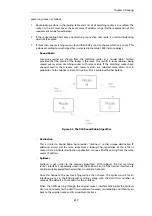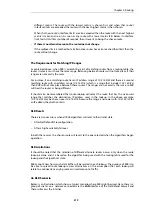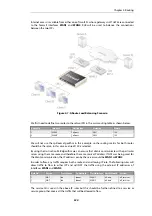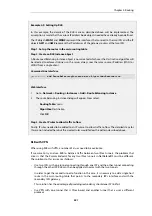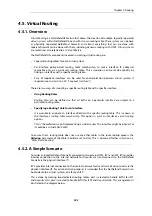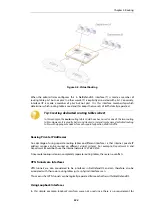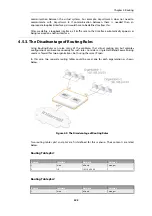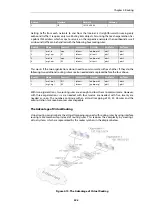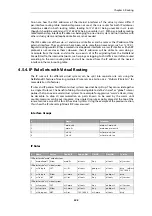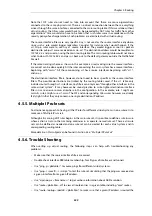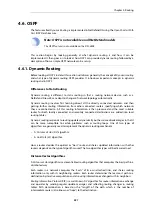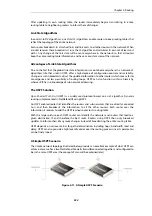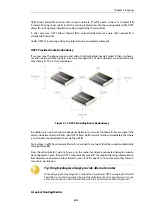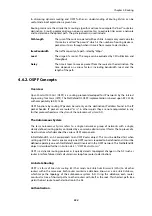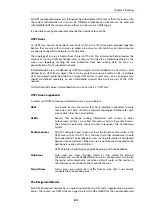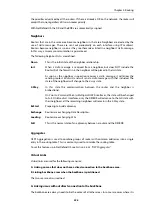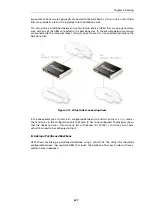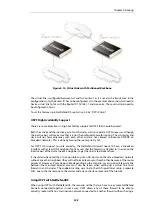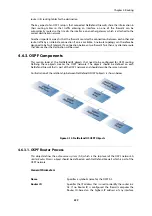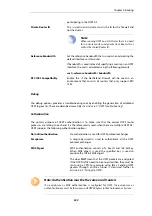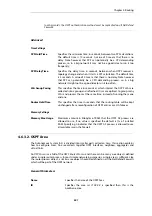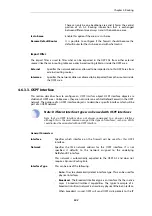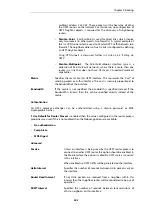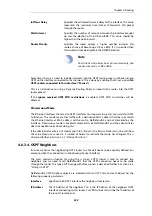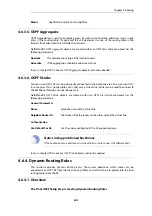
4.6. OSPF
The feature called
Dynamic Routing
is implemented in NetDefendOS using the
Open Shortest Path
First
(OSPF) architecture.
Note: OSPF is not available on all NetDefend models
The OSPF feature is not available on the DFL-260E.
This section begins by looking generally at what dynamic routing is and how it can be
implemented. It then goes on to look at how OSPF can provide dynamic routing followed by a
description of how a simple OSPF network can be set up.
4.6.1. Dynamic Routing
Before looking at OSPF in detail this section will discuss generally the concept of
Dynamic routing
and what type of dynamic routing OSPF provides. It introduces important concepts in dynamic
routing and in OSPF.
Differences to Static Routing
Dynamic routing is different to static routing in that a routing network device, such as a
NetDefend Firewall, can adapt to changes of network topology automatically.
Dynamic routing involves first learning about all the directly connected networks and then
getting further routing information from other connected routers specifying which networks
they are connected to. All this routing information is then processed and the most suitable
routes for both locally connected and remotely connected destinations are added into local
routing tables.
Dynamic routing responds to routing updates dynamically but has some disadvantages in that it
can be more susceptible to certain problems such as routing loops. One of two types of
algorithms are generally used to implement the dynamic routing mechanism:
•
A
Distance Vector
(DV) algorithm.
•
A
Link State
(LS) algorithm.
How a router decides the optimal or "best" route and shares updated information with other
routers depends on the type of algorithm used. The two algorithm types will be discussed next.
Distance Vector Algorithms
A
Distance vector
algorithm is a decentralized routing algorithm that computes the best path in a
distributed way.
Each router in a network computes the "costs" of its own attached links, and shares routing
information only with its neighboring routers. Each router determines the least-cost path to a
destination by iterative computation and also using information exchanged with its neighbors.
Routing Information Protocol
(RIP) is a well-known DV algorithm for router information exchange
and operates by sending regular update messages and reflecting routing changes in routing
tables. Path determination is based on the "length" of the path which is the number of
intermediate routers (also known as "hops") to the destination.
Chapter 4: Routing
331
Summary of Contents for NetDefendOS
Page 30: ...Figure 1 3 Packet Flow Schematic Part III Chapter 1 NetDefendOS Overview 30 ...
Page 32: ...Chapter 1 NetDefendOS Overview 32 ...
Page 144: ...Chapter 2 Management and Maintenance 144 ...
Page 284: ...Chapter 3 Fundamentals 284 ...
Page 392: ...Chapter 4 Routing 392 ...
Page 419: ... Host 2001 DB8 1 MAC 00 90 12 13 14 15 5 Click OK Chapter 5 DHCP Services 419 ...
Page 420: ...Chapter 5 DHCP Services 420 ...
Page 573: ...Chapter 6 Security Mechanisms 573 ...
Page 607: ...Chapter 7 Address Translation 607 ...
Page 666: ...Chapter 8 User Authentication 666 ...
Page 775: ...Chapter 9 VPN 775 ...
Page 819: ...Chapter 10 Traffic Management 819 ...
Page 842: ...Chapter 11 High Availability 842 ...
Page 866: ...Default Enabled Chapter 13 Advanced Settings 866 ...
Page 879: ...Chapter 13 Advanced Settings 879 ...

